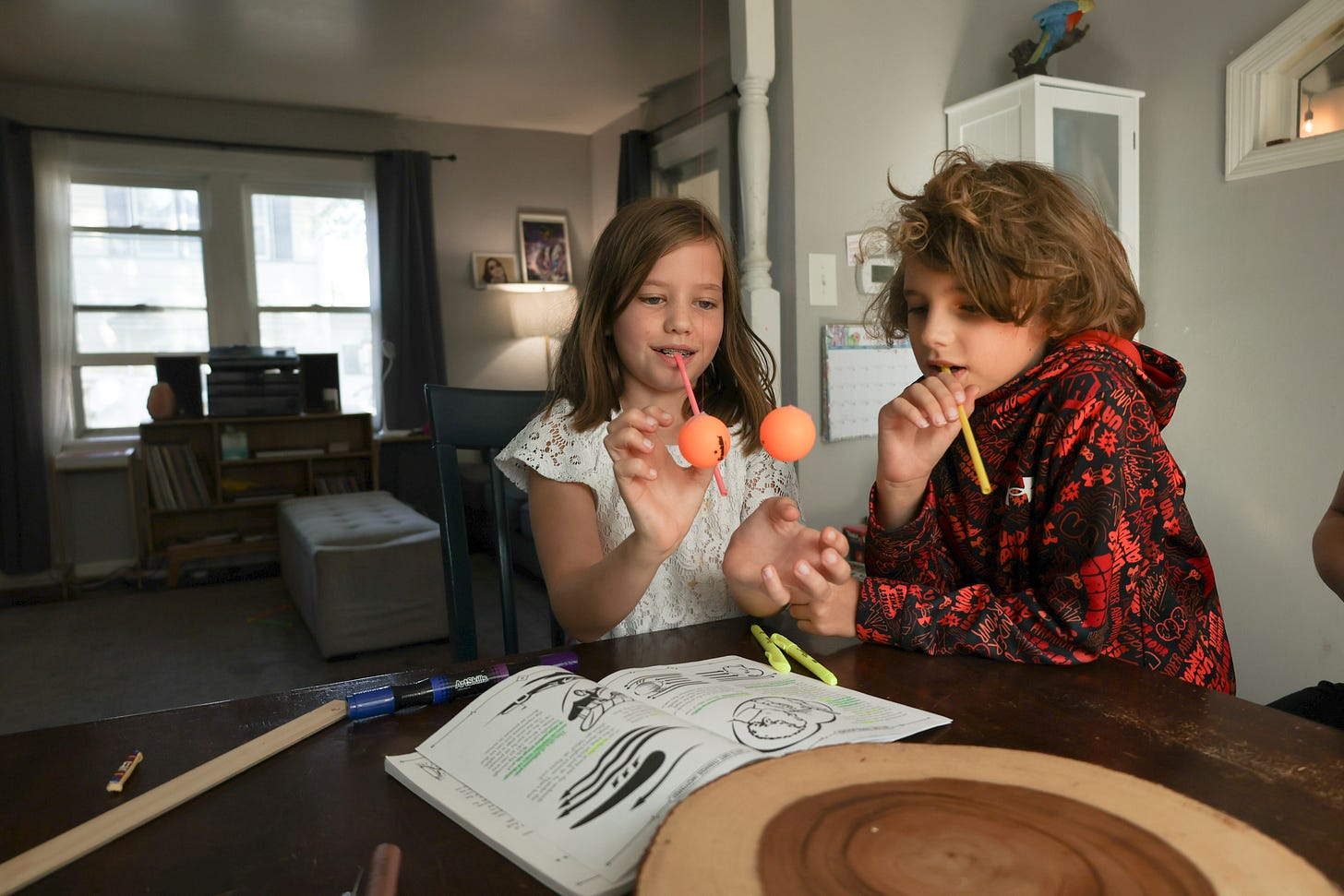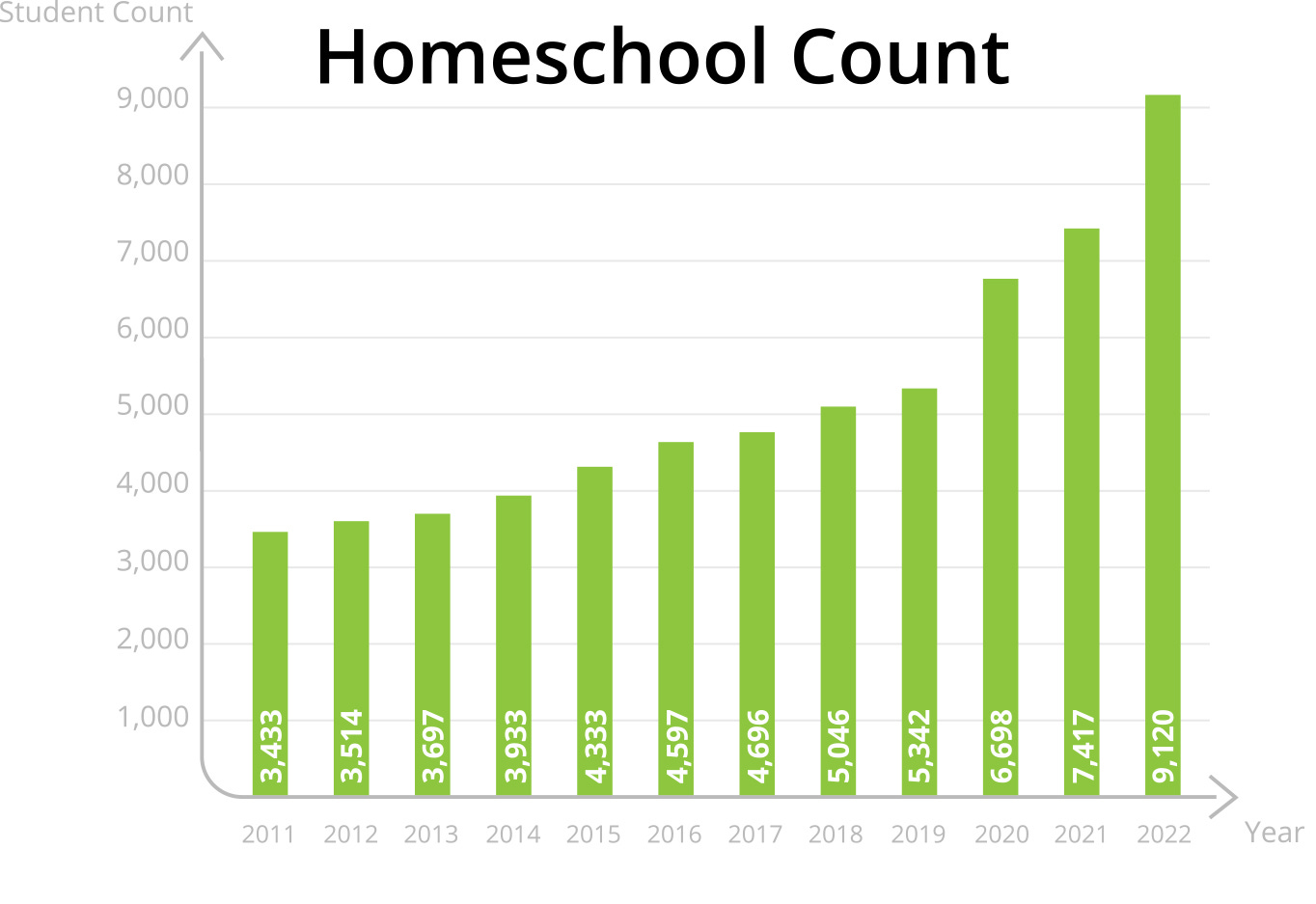Competing for kids: School districts struggle to stop exodus of homeschool students
Increased access to alternative curriculums, dissatisfaction behind explosion in number of South Dakota kids getting alternative education
The number of South Dakota children getting their education outside of a traditional school setting is skyrocketing in South Dakota.
But school districts are doing little to stop the outflow of students from their buildings despite the tens of millions in annual revenues the trend is costing them.
An analysis of Department of Education enrollment data by The Dakota Scout revealed the number of children statewide getting “alternative instruction” — as homeschooling is officially categorized — has spiked by 165 percent since 2011. That year, 3,400 kids were being schooled outside of a public or private school. By 2022, that number ballooned to 9,120.
And the latest head count, anticipated to be released by DOE in the coming weeks, could see the number exceed 10,000 if trends hold. Those figures are outpacing population growth. And at about $7,000 a head — the base amount districts receive for each student using their desks — that’s more than $63 million districts are missing out on.
It’s also why some districts are reaching out to their homeschool communities.
In Rapid City, the school district last month distributed about 1,000 mailers to households where students had dropped attendance in recent years to encourage them to return to public school.
NEWS: Noem’s office says it didn’t tip off Ohio company leading Freedom Works Here marketing blitz
“RCAS (Rapid City Area Schools) is a growing community, yet our student numbers have remained steady,” RCAS Superintendent Nicole Swigart told The Dakota Scout after the postcards raised some consternation among homeschool families who received them. “Like many communities around the nation, we have students who have never returned to school after COVID. The postcards were merely an avenue to encourage anyone who wants to learn more about RCAS schools to call and discuss enrolling with us.”
While the Meade School District, where homeschool numbers jumped nearly 20 percent last year alone, did not respond to multiple requests for comment, the head of a Black Hills-based homeschool advocacy group says that district’s administrators have started conversations with homeschool groups to gather feedback and discuss how the district and parents choosing alternative instruction might collaborate in and outside of the classroom.
“Other school districts are inviting homeschool families to events,” said Jen Beving, founder of Black Hills Home Educators. “Those are more well received.”
However, officials in other school districts say there’s not much they can do to lure kids back into their buildings, partly because keeping records on where those students are is difficult.
In Sioux Falls, for instance, district officials say a recent law change requiring homeschool student records be dropped from its rolls has made outreach a challenge.
“SFSD (Sioux Falls School District) receives notification from the state . . . when a family has filed for homeschooling. At that time, we are required to drop them from our ‘rolls,’” said DeeAnn Konrad, community relations coordinator for SFSD. “At that point, it is the state who communicates with them about their ability to participate in activities or take a single course(s).
“We do not have a means to contact these families unless they contact us and enroll their child,” she added, noting a lack of marketing dollars to recruit or to encourage kids to re-enroll.
Competing for kids
South Dakota Education Secretary Joseph Graves, though, said districts have access to DOE data that accounts for every homeschool student in their jurisdiction. Even so, simply asking families to reenroll their kids in public school won’t be enough, he said.

Rather, education is similar to other industries in that various methods of teaching are in competition for the same pool of kids. And with homeschooling becoming more socially accepted in recent years while at the same time access to homeschool curriculum has improved, the districts face more competition than ever before.
That’s not a bad reality, he said.
NEWS: Regents want control of Noem's 'woke' tip line, governor's office declines
“I know some people view this as a negative or a positive, but truthfully, it’s a healthy part of a field of endeavor where you want excellence — to have serious competition,” said the longtime Mitchell superintendent who joined Gov. Kristi Noem’s cabinet earlier this year. “Having good homeschools, having great private schools and having public schools around you that can also accept your students makes all of us better.”
When the homeschool movement first began in the 1960s and 1970s, Graves said some families choosing alternative instruction were dissatisfied that prayer was removed from public school systems, for example. And as homeschooling has become more mainstream over the years, regulatory hurdles around alternative instruction have also come down.
South Dakota saw its largest year-over-year jump in homeschool students from 2019 to 2020 when the number of kids getting an alternative instruction jumped by more than 25 percent. Graves said while some parents chose not to send their children back to a school building because of mask mandates and other Covid protocols put in place by school boards, some also kept their kids home because they didn’t think schools were doing enough to mitigate the spread of the flu-like virus.
But with the pandemic all but in the rearview in South Dakota, the number jumped another 10 percent in 2021 before the law change preceded another 23 percent spike last year.
Those figures are alarming to the education establishment, which harbors skepticism about the benefits that more homeschooling brings. South Dakota’s education lobby fought vigorously against a measure in 2021 that dropped a requirement that homeschool families obtain approval from school districts each year. And the bill’s passage also resulted in homeschool students no longer having to submit to standardized testing.
And that means neither districts nor the state education department have the ability to track performance or effectively enforce truancy laws.
Homeschool advocates cite ACT scores and other metrics when making the case for educational choice. But those data points are not comprehensive of all students that make up the alternative instruction counts each year because not all of those children opt to take the exams, said Cynthia Mickelson, a former Sioux Falls School Board member who served when the 2021 homeschool reforms were passed by the Legislature and signed by the governor.
“What I was worried about was with the loopholes that were created with the new law … there was going to be a gaping hole with families who might not have the best interest of their kids’ education,” she said. “Competition is a good thing, but there are people using the system to escape.”
Graves said DOE is aware of the existing homeschool regulatory structure here leaving the public education system vulnerable to early drop-out abuse. And the department is actively working with school districts to assess how often that’s occurring and what, if anything, can be done to address it.
“It’s a difficult issue to square away, because how do you then give homeschoolers their legitimate right to teach their kids the way they want to do that while closing off the drop out safety valve?” he asked.
NEWS: Communities prepare to receive long awaited 'workforce housing' money









The top reasons for a family to choose alternative instruction are 1) the kid isn’t excelling and 2) bullying.
Beyond that, the data on our public school failures are well documented, though they never seem to make these types of articles about parents choosing different paths for their kids’ education.
For example, in Pierre, HALF our kids aren’t proficient in reading, math or science. And the request for a strategic plan to turn things around (even just the request to get rid of our failed balanced literacy program) has been totally ignored.
The best part? Our Pierre administrators love to cite that Pierre is better than the SD average. Lol.
Last point. I love when school administrators like Cynthia pretend like so many of these homeschool kids could be falling through the cracks (with zero evidence to prove it). And yet she never mentions the thousands (maybe tens of thousands) of kids who come to school religiously but can’t demonstrate proficiency on any of our state tests.
The stats to this point on homeschooling are awesome - congrats to everyone who worked on the ‘21 legislation to make this possible. It’s only a matter of time before the state GOP gets the courage to aggressively put an end to the failed monopoly that is public education in this state. Tick. Tock.
Schools seem to only see dollar signs when they see our kids. They certainly have not been actually educating our kids when proficiency rates are absolutely abysmal (averaging less than 50% for math, science, and grammar)...and they’re concerned about a few homeschoolers not taking standardized tests...really?! We homeschooled our two sons and gave them a far better education than the public school ever could have. Not every family is able to homeschool though and for them there should be a public school system that actually educates the child and doesn’t just try to get them to fill a seat so they can more money to pay superintendents and administrators ridiculously bloated salaries for results that should demand they get far, far less! Competition is a great thing and if this spurs the public school system to rethink their approach, that’s a great thing!